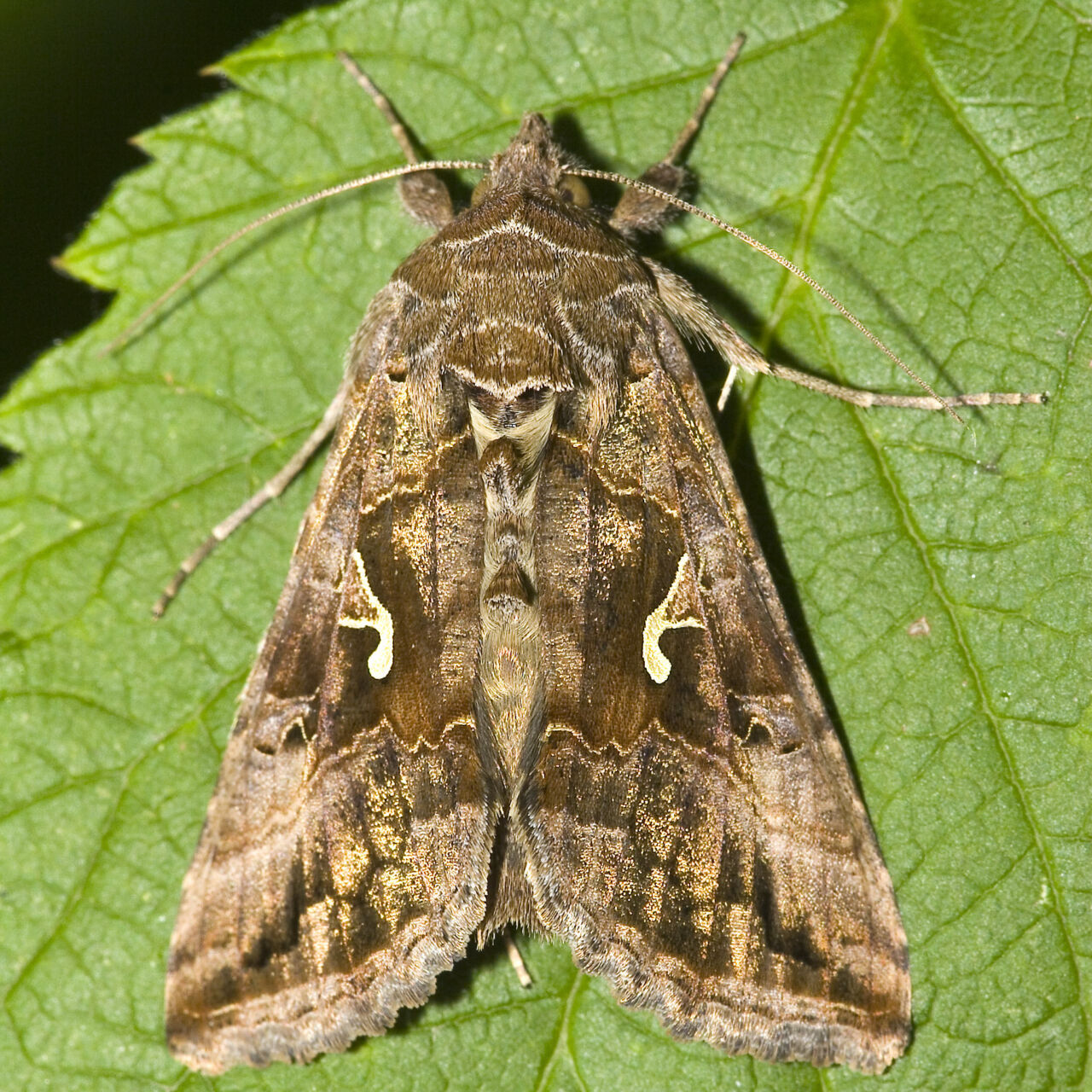Why the Y? The silver Y moth
Although a feared pest when it occurs in great numbers, this migratory moth provides important pollination services to a variety of plants.

The brownish coloration of the silver Y moth serves as camouflage. Image: Adobe Stock
Profile
- The silver Y moth, Autographa gamma, is a migratory moth of the family of Noctuidae.
- They are medium sized with a wingspan of 30–45 mm and patterned in various shades of brown and grey. Their brownish coloration serves as camouflage.
- Each forewing has a whitish mark in the center in the shape of the letter y or the Greek lower case letter gamma (g). This is what put the Y in the moth's English name and gave it its German name Gammaeule.
- Silver Y moths can be found in a variety of habitats, such as grasslands, coastal areas, wetlands and woodlands, but also gardens and farmlands. Generally, they prefer open areas.
- They are found throughout Eurasia and North Africa.
Classification
- Kingdom
- Animalia
- Phylum
- Arthropoda
- Class
- Insecta
- Order
- Lepidoptera
- Family
- Noctuidae
- Genus
- Autographa
- Species
- A. gamma
Life Cycle
The life cycle of the silver Y moth is similar to any moth's life cycle. Each egg is laid individually on the underside of a leaf. Larvae hatch after 3–4 days and require 13–17 days to fully develop and go through all six larval instars*. Caterpillars of the silver Y moth are pale green with whitish strips on their dorsal* side. They easily reach 2.5–3 cm in length during the sixth instar. They feed on a variety of low-growing plants such as meadow sage (Salvia pratensis), common nettle (Urtica doica), peas, sugar beet and cabbage. Their leaf damage can reduce crop yields significantly. Eventually, the larva will pupate on the underside of the leaf and cover itself in a silken cocoon. The pupa is green but darkens and turns black with time. Only a few days after they emerge, the adults seek mating partners and the life cycle starts again.

Look at the photo carefully. Can you spot the Y letter? Image: Wikimedia Commons/Olei, CC License
Fleeing the summer, fleeing the winter
Silver Y moths are long-distance migratory moths. In spring, they migrate in high numbers from the Mediterranean area up to their summer breeding sites in central and northern Europe, reaching Iceland, Greenland and Finland. In late summer and fall, the new generations of moths migrate back to southern Europe to spend the winter at their winter breeding sites. A new generation of immature moths will be ready to migrate again in spring.
Migrating individuals usually have a fitness benefit, meaning they reproduce more successfully and live longer compared to non-migrating individuals. Females of the silver Y moth, for example, were observed to lay fewer eggs the higher the temperature gets. Migration allows them to avoid unfavorable environmental conditions such as hot summer temperatures. Interestingly, only immature adult individuals of the silver Y moth migrate. Reproduction and migration seem to alternate. Migration is triggered in immature individuals probably by perception of temperature and photoperiod (the duration of night or day). After migration, the reproductive diapause* is terminated, again by perception of photoperiod, temperature but also physiological changes.
Trapped by sex-pheromones
Sexually mature silver Y moths communicate with each other via a species-specific blend of sex-pheromones. Based on this, traps with synthetic lures mimicking sexually mature moths were invented to deal with Autographa gamma, an important pest, whose caterpillars dramatically reduce the yield of crop species such as peas and cabbage. Most lures are attractive for both sexes or preferably females. Knowing how many females are near a crop field, one can estimate whether they will soon be laying eggs on the plants. This allows more precise pest control by using pesticides only when necessary to deal with eggs or caterpillars.
Adult moths not only respond to sex-pheromones but are attracted by the odor of flowers for nectar feeding, too. Especially after a long inter-continental migration, they are hungry and need to refuel their energy sources before searching for mating partners. Silver Y moths are attracted to a variety of plants and therewith provide pollination services. To support butterflies and moths in your garden, plant nectar-rich flowers such as autumn crocus (Colchicum autumnale) for the moths, and cabbage (Brassica olearacea) or peas (Pisum sativum) for the caterpillars, and provide shelter such as climbing ivy or shrubs as overwintering sites. Or invite Ronaldo for tea.
Fun Fact
Silver Y moths caused a stir at the France vs. Portugal match in the 2016 European Football Championship when they fluttered into the stadium in their thousands. The floodlights, which were already burning the night before the game, had attracted them. A moth that settled on Cristiano Ronaldo's face caused particular hilarity. Why moths are attracted to artificial light has not yet been fully explained. Their thirst for human sweat may indicate a lack of sodium in their usual diet.
To view this content, you must accept marketing and third-party cookies.
*Glossary
Diapause: Insects facing reoccurring unfavorable environmental conditions delay their development to enhance their survival rate. Diapause can be induced or inhibited by environmental factors such as temperature or day length and it slows down the feeding rate and reproductive development.
Dorsal: On the back
Instar: Developmental stage between two moults.
References
Becher PG and Revadi SV, 2020. Current knowledge on the migratory moth Autographa gamma as basis for future chemo-ecological research. Integrative Biological Control. PIBC, 20: 191. http://dx.doi.org/10.1007/978-3-030-44838-7_12
Toth M et al., 2019. Improving bisexual lures for the Silver Y Moth Autographa gamma L. and related Pulsinae (Lepidoptera: Noctuidae). Acta Phytopathologica et Entomologica Hungarica, 54 (1): 137. https://doi.org/10.1556/038.54.2019.012
Wallrodt L, 2016. Darum kriegte Cristiano Ronaldo die Motten. Die Welt. https://www.welt.de/sport/fussball/em-2016/article156953639/Darum-kriegte-Cristiano-Ronaldo-die-Motten.html, accessed April 2023
Chapman JW et al., 2013. The significance of midsummer movements of Autographa gamma: implications for a mechanistic understanding of orientation behavior in a migrant moth. Current Zoology, 59: 360. http://dx.doi.org/10.1093/czoolo/59.3.360
Plepys D et al. Volatiles from flowers of Platanthera bifolia (Orchidaceae) attractive to the silver Y moth, Autographa gamma (Lepidoptera: Noctuidae) https://doi.org/10.1034/j.1600-0706.2002.990107.x
